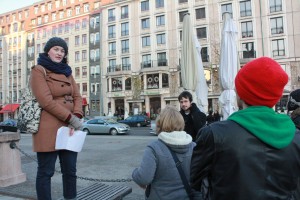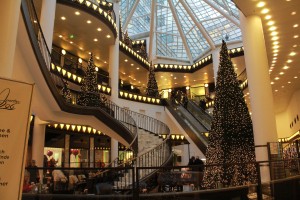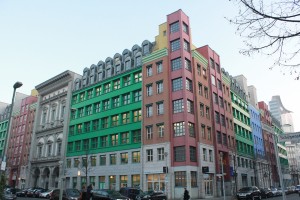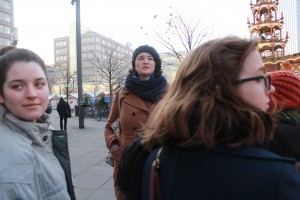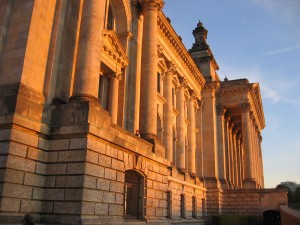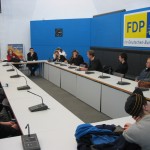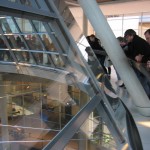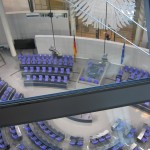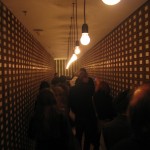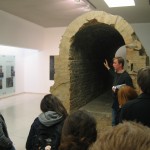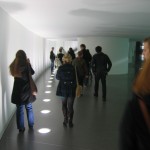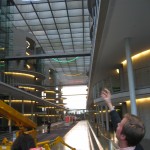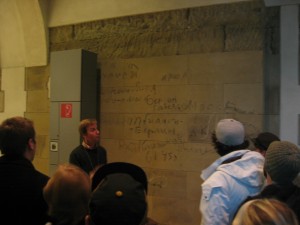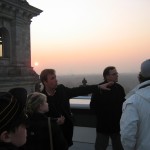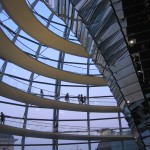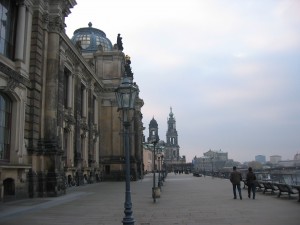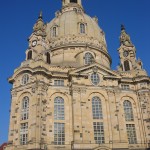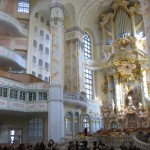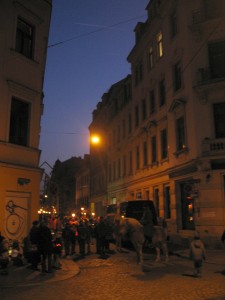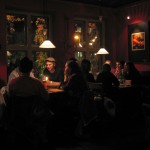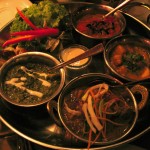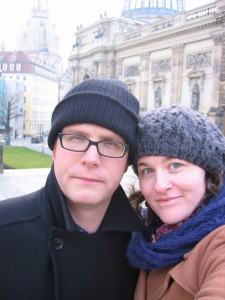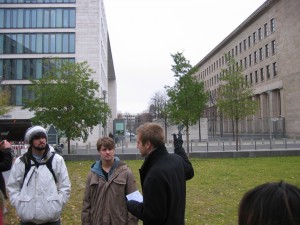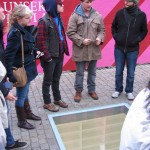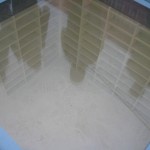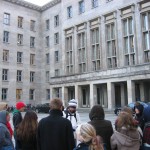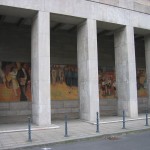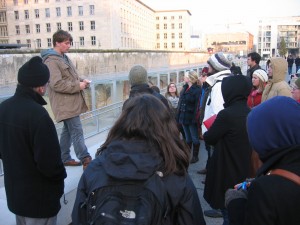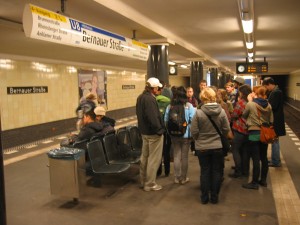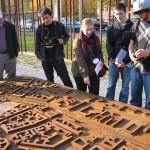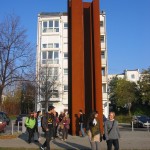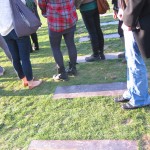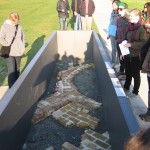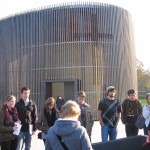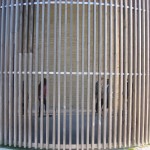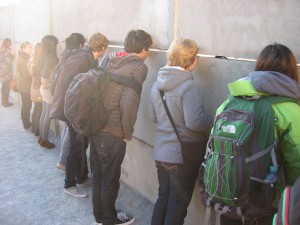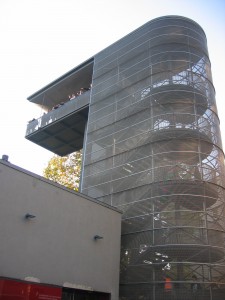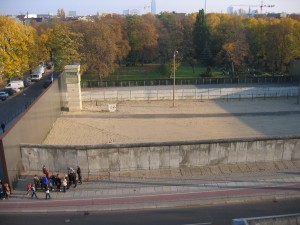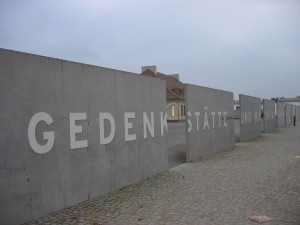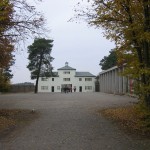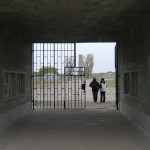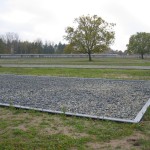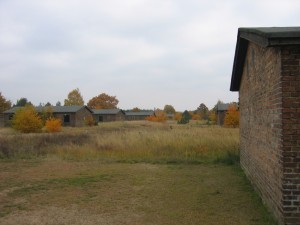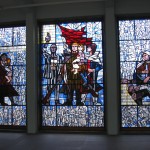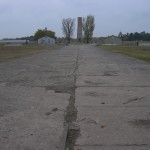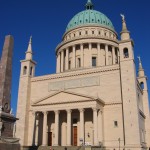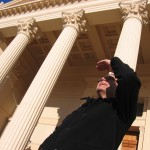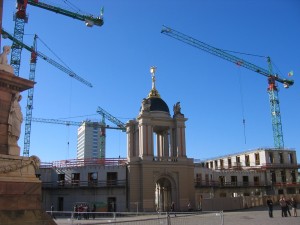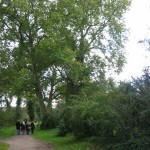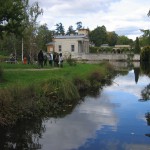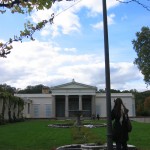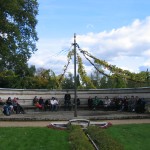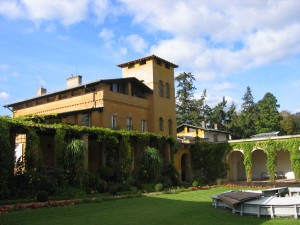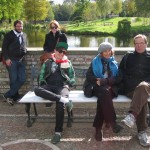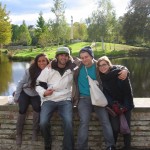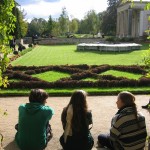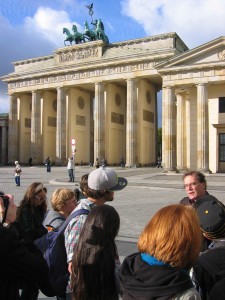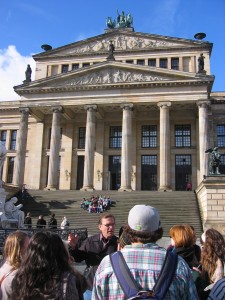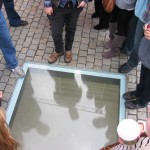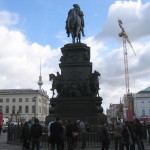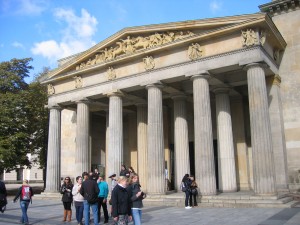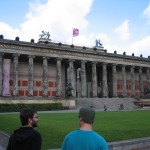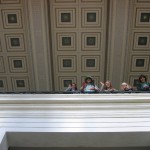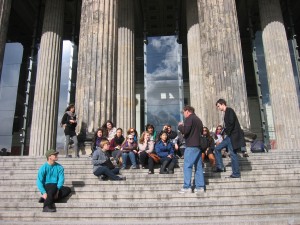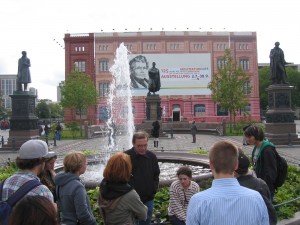A tour of Critical Reconstruction in Mitte with Nara
This week, I took the students on a tour focusing around the reconstruction of Mitte, the central district of Berlin. The guiding principle for this has been the concept of “Critical Reconsruction,” a set of city planning and architectural approaches that emphasize traditionalism and history.
One of the amazing things about this approach is the way that different architects have responded to the task: in Pei Cobb Freed’s Quartier 206 building, for instance, the idea of a turn-of-the-century shopping gallery has been combined with modern materials and geometries to create a rich amalgam of yesterday and today.
The same can be said for this building by Aldo Rossi. Rossi’s writing was incredibly influential on Critical Reconstruction theory, because he emphasized issues of memory – not only official, public memory, but personal and dream-like memory – in his work. As we’ve seen this quarter, Berlin is nothing if not memory-laden …
As visually appealing as much of Critical Reconstruction is, there are also problems with it. One of these is the rhetoric used by planners and architects in order to push certain projects through. Spaces such as Alexanderplatz – remodeled thoroughly in the 1960s – were dubbed “totalitarian” or “socialist,” when they actually embodied architectural types that were typical of Western architecture. This kind of language masks the real target of Critical Reconstruction: the Modernist architecture that preceded it!
As we move into an exploration of Berlin’s contemporary issues, the rifts in the various discourses about identity and space will continue to become more and more apparent.
*Special thanks to Ryna Chin for the great photos!
A visit to the Reichstag
Our activities this week included a tour of the Reichstag (the German parliament building).
Our guide was Ulli Finkenbusch, who works for the Free Democratic Party (FDP). After an introductory discussion about some important political issues facing Germany, we took a tour of the building, beginning with the mezzanine level.
On the lower level of the main parliament building, we viewed an artwork by Christian Bolstanski (left), consisting of metal boxes with the names of all the German Parliament members since 1919. We also saw the remains of the tunnel through which the arsonist who set fire to the Reichstag in 1993 is supposed to have entered building.
We then traversed the underground walkway connecting the Reichstag with the parliament meeting rooms and offices in the Paul-Löbe-Haus.
On our way back through the Reichstag, we glimpsed graffiti left by Soviet soldiers in 1945, which has been preserved as part of the integral history of the building.
Our final stop was on the roof, where Ulli pointed out several of the city sights that are visible from there, and we enjoyed a beautiful sunset!
Dresden: Florence on the Elbe
This Friday and Saturday our class took a trip to Dresden, a beautiful baroque city on the banks of the Elbe River.
The students explored several of the historic sites in the city, including the Frauenkirche. Once a famous ruin symbolizing the firebombing of Dresden, the church has been recently reconstructed.
Since the students were all responsible for seeing the sights on their own, we don’t have images of their explorations, but you can see Annie’s, Mariah’s, Melissa’s or Robert’s blogs for their own photos.
We also learned about an interesting German holiday in Dresden: St. Martin’s Day. Families walk together around the city holding lanterns. All of the cute little kids and their homemade lanterns were quite a sight!
On Friday night, we enjoyed a delicious group dinner at a local Indian restaurant!
… and Chance and I enjoyed Dresden, too!
A tour of Nazi architecture in Mitte with Max, Klayton and Nick
Our theme for this week is the rebuilding of Berlin after the fall of the wall, and one of the things that architects, planners and politicians had to contend with was the history of totalitarianism that was still inscribed on the landscape. To deepen our understanding of this issue, our students Nick, Max and Klayton took us on a tour of sites in Mitte with Nazi history today.
The first stop on the tour was the Foreign Ministry, housed in the former Nazi Reichsbank (the browner building to the right). The first freely elected East German parliament also met here for a time in 1989-90, as they negotiated their integration with the West. In the early 1990s, a “Critical Reconstructionist” architect designed an addition (left). This is an approach, used throughout the center of the new Berlin, that seeks to integrate historical building traditions with modern design.
Next, we visited the memorial to the Nazi book burnings on Bebelplatz, right in front of the Humboldt University buildings.
The current Finance Ministry is housed in another interesting building with a layered history. Built to house the Nazi Air Ministry, it then became home to the GDR’s Council of Ministers after 1949. A socialist realist mural (right) was added at this time. The site is also known for its association with the workers’ uprising in 1953, and there is a memorial to this event on the grounds today.
Our last stop on the tour was the Topography of Terror, a site that contains the excavated remains of the Gestapo headquarters, as well as a museum dedicated to the history of Nazi-sponsored persecution. The Berlin Wall also ran along the edge of the site, as you can see above.
We’ll continue our exploration of Berlin’s responses to its own layered past next week, when we’ll be focusing on issues of memorialization.
A Tour of the Bernauer Strasse Wall Memorial with Libby, Roxana and Dominic
This week our students Libby, Roxana and Dominic took us on a tour of the Berlin Wall Memorial on Bernauer Strasse. We started the tour in the subway station, which during East German times had been a “ghost station” — because it lay in the East, it was a place that West German subways passed through but did not stop. Sometimes armed guards could be glimpsed in the darkened stations, but otherwise they were silent. Now they’ve been restored, and the U8 train stops at all the stations between Moritzplatz and Voltastrasse once more!
Emerging at street level, we entered the memorial site, which stretches for several blocks. The park encompasses what was formerly the ‘death strip’ – the space in between the two halves of the wall that divided East from West. Our tour guides directed us toward the many markers of structures that once existed on the site, including escape tunnels (right).
One of the most remarkable structures to have inhabited the death strip was an entire church, paradoxically named the Church of Reconciliation. It was demolished in the early 1980s by the East German government, but the foundations remain (left) and are now incorporated as relics in the park. A chapel has been built on the site to commemorate the many who died trying to escape over the wall.
Another portion of the park contains a reconstruction of the wall as it existed during East German times. This consists of a wall on the east side, then a large expanse of sand and barbed wire, and then finally another concrete wall on the west side. From the viewing tower that is part of the memorial museum (below), you can look down into this reconstructed portion.
Perhaps what is most amazing about this site is that it’s one of the only places in Berlin that you can tell there was ever a wall at all! The rest of the city has been so thoroughly sutured back together that you really have to hunt for the traces. This park preserves the memory of the terror that the wall once represented for Berlin’s citizens.
KZ Sachsenhausen: four layers of memory
Our visit to Buchenwald last weekend left us all with much to think about concerning the troublesome history of the Holocaust and the aftermath of WWII. This past Friday, we visited another concentration camp site, this time much nearer to Berlin. As opposed to Buchenwald, which is somewhat removed from the town of Weimar, Sachsenhausen is set essentially within the town of Oranienburg. The students were shocked to see how close the camp was to the surrounding houses: it reveals much about the attitude of many Germans toward the existence of these sites during the Nazi era.
The exhibitions and interpretive materials on the site (which is still in the process of being remodeled) seek to reveal four major eras in the camp’s existence. The first is the building and use of the camp by the Nazis, beginning in 1936. Though many Jews were imprisoned here, it was better known as a camp for political prisoners, especially Communists. It was also a prominent training site for the SS, as well as a “show” camp for Hitler and his officials. Though it wasn’t a death camp, tens of thousands of prisoners died here as a result of starvation, disease, abuse, and torture, as well as medical experiments.
After the war, the Soviets used Sachsenhausen as a “special camp” where they held various German prisoners to await trial. (Above: extra housing outside the camp walls which was used during this time.) Several thousand people died during this stage of the camp’s existence – mostly of starvation, disease and exposure. It’s difficult to know what to do with the memory of these deaths, as many of the prisoners were either Nazis themselves, or had been willing participants in the culture of the regime. Still, the evidence of human suffering here is also staggering.
After the Soviets abandoned the camp, the GDR government refurbished it (as they did Buchenwald) as a memorial site. Here at Sachsenhausen, this included a large memorial structure (where soldiers were regularly inducted into the army), as well as a museum that emphasized the suffering of the Communist prisoners held here by the Nazis. For East Germany, the identity of the Communists as victims of the fascist regime was a central part of the national narrative, so sites like these became points for the public expression of collective persecution at the hands of the Nazis – even if very few GDR citizens had actually been Communists prior to 1945. On the other hand, the memory of the Soviet camp was completely suppressed under the East Germans, so that families who had lost loved ones here during the post-war period were unable to speak about their own suffering until after 1989.
With the fall of the wall, the camp became a flashpoint for conflicting narratives and memories: how can both victims of the Nazis and Nazis or collaborators themselves be remembered and mourned on the same site? This is a question that haunts many spaces in Berlin, not only Sachsenhausen. The current design of the site attempts to deal with this through a “decentralized” approach, using the various structures to house extensive exhibitions of archival material. Still, we’re left wondering: how do we decide who has the right to be remembered, and how?
There are many more buildings on the site, but I couldn’t bring myself to photograph them. Sites of terrible suffering and unspeakable crimes, I think they are best left to be pondered in the abstract. If you’re interested, however, you can read more about the site here.
A day in Potsdam
Our day trip to Potsdam featured more of our favorite 19th-century designer, Karl Friedrich Schinkel. (You probably think we’re just obsessed with him, but believe us – he truly was great!) We began at the St. Nikolaikirche near the city center. It was begun according to plans by Schinkel, but finished by his student Ludwig Persius.
Berlin isn’t the only city that is rebuilding past monuments – here you can see that Potsdam is also busily rebuilding its royal palace (across from the Nikolaikirche), as a home for the state parliament. Meanwhile, East German buildings on the other side of the square are slated for demolition and replacement.
A trek across Potsdam and through Sanssouci park brought us to another Schinkel site, this one built for a very elite audience – the crown prince.
Schinkel built a tiny summer palace (really the size of a summer home) for the prince, who was a prolific artist and designer himself. Together, they fashioned what the prince referred to as “Siam” – a utopian space filled with rich symbolism, much of which is now lost on those of us without the proper classical education!
Schinkel also designed a house for the court gardener, which later became a billiards room, tea lounge and general garden leisure space for the prince and his friends.
We took some leisure time ourselves – to contemplate the connection between human constructive activity and that of nature, as Schinkel intended – before heading off on our own walks through the rest of Sanssouci park. Next week: Berlin around the turn of the century!
A walk through Schinkel’s Berlin with John Toews
On Wednesday John took us on a tour of Berlin’s historical district, known as Mitte. The focus of our walk was the city as it was in the 19th century, when its inhabitants included some of the leading intellectuals of the time, and the city styled itself as “Athens on the Spree.” We began at the Brandenburg Gate, designed by Carl Gotthard Langhans in the late 18th century as a kind of propylaea leading into Berlin. Karl Friedrich Schinkel had a hand in redesigning the staff held by the goddess of peace who crowns the monument.
We continued on to Schinkel’s Schauspielhaus (now called the Konzerthaus) on the Gendarmenmarkt, a somewhat early commission and an example of the architect’s turn toward neoclassicism.
On the Forum Fridericianum, a square built under Frederick the Great (whose monument you see on the right), there is now a memorial to the book burnings that took place there in the 1930s. The square is home to the former Royal Library, now housing Humboldt University’s law school. Interestingly, we learned that the book burnings were not carried out by Nazi officials, but rather by zealous student party members.
Next stop: the Neue Wache, a guardhouse designed by Schinkel along Unter den Linden. The building has been the site of numerous memorials over the course of the 20th century, including both East German and reunified German commemorations of World War II.
One of Schinkel’s masterpieces, not only of architecture but of urban planning, is the Altes Museum. Sitting across from the site of the royal Prussian palace (not currently extant), the building housed the first true modern museum in Europe. Schinkel designed it to integrate the viewer’s experience of art with that of the urban environment: he provided a viewing platform on the interior of the building, from which visitors could contemplate the royal gardens, palace, and the cityscape beyond.
The tour wrapped up near the site of Schinkel’s Bauakademie – his architectural and design academy. The building is also considered one of his masterworks, and was unfortunately torn down in the post-WWII period. This nylon-covered scaffolding has been here for years, but there’s no money to rebuild it. Its ghostly presence reminds us of the many memories and layers that reside amongst one another in Berlin’s cityscape.
tags
the author
I'm a doctoral student at CUNY Graduate Center. I'm thrilled to be teaching the CHID Berlin program with Prof. John Toews! You can contact me at naraelle [at] gmail.com, or find out more about me at www.naraelle.net.
Blogroll
- Annie Holden's blog
- Cassie Hoeprich's blog
- Dominic Barrera's blog
- Janet Williams's blog
- Mariah Alderete's blog
- Melissa Au's blog
- Robert Hampton's blog
- UW Students Study Abroad Our students Natalie and Cassie are contributing to the official IPE student blog this fall!



